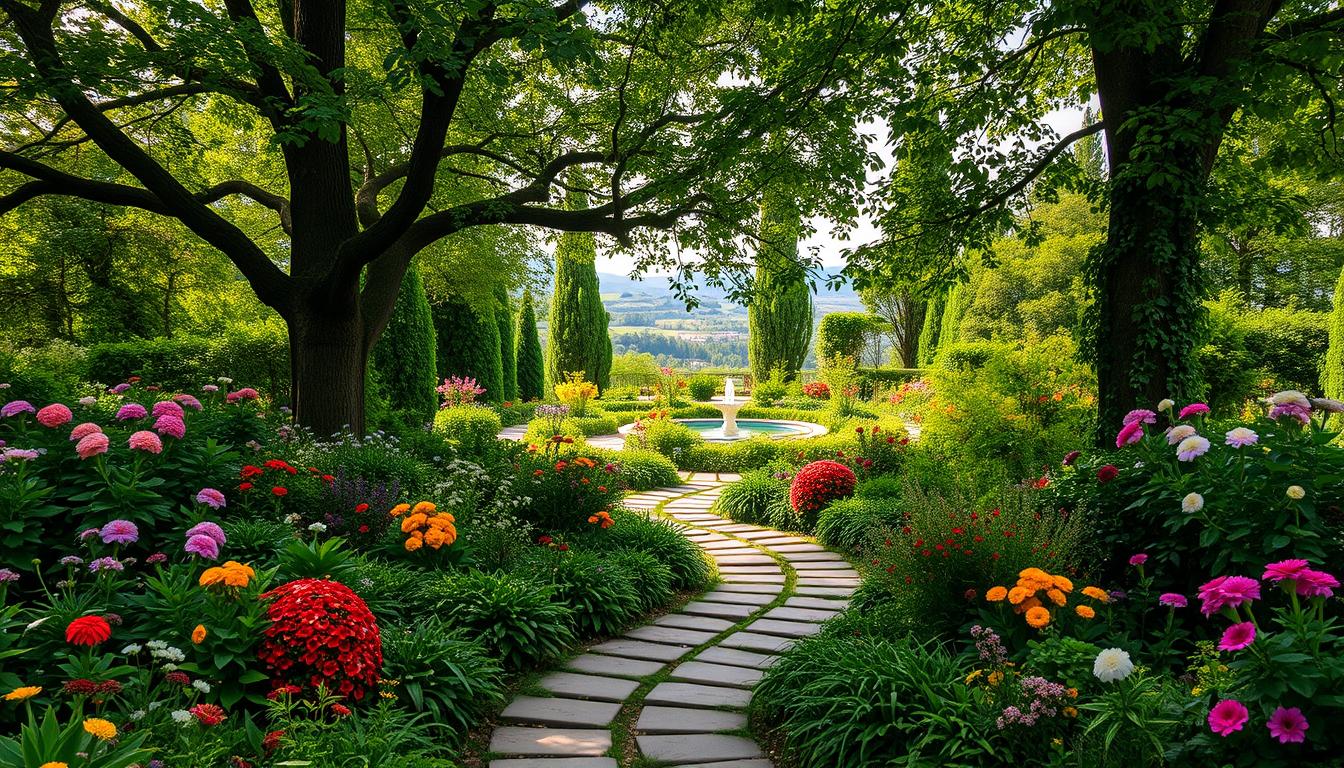Creating a beautiful and functional outdoor space is easier than you think. Whether you have a small balcony or a sprawling backyard, thoughtful planning can transform any area into a stunning retreat. With the right approach, you can maximize both aesthetics and practicality, ensuring your space works for you year-round.
Seasonal adaptability is key to maintaining visual interest. From vibrant spring blooms to cozy winter arrangements, your outdoor area can shine in every season. Urban dwellers and rural homeowners alike can benefit from tailored solutions that fit their unique needs.
In this article, we’ll explore nine distinct approaches to help you craft the perfect outdoor haven. Each idea is designed to inspire and guide you, no matter your experience level. Let’s dive in and discover how to bring your vision to life!
Key Takeaways
- Strategic planning enhances both beauty and functionality.
- Seasonal adaptability ensures year-round appeal.
- Solutions are tailored for urban and rural spaces.
- Nine unique approaches to inspire your creativity.
- Easy-to-follow ideas for all skill levels.
Introduction to Garden Design Plans Ideas
A well-thought-out outdoor area can solve common challenges while reflecting your personal style. Whether you’re dealing with limited space or poor soil, smart planning ensures your landscape thrives. By addressing these issues, you create a space that’s both functional and beautiful.
Matching your outdoor area to your lifestyle is crucial. Think about how you’ll use the space—whether for relaxation, entertaining, or growing your own food. This ensures your gardening efforts align with your daily needs and preferences.
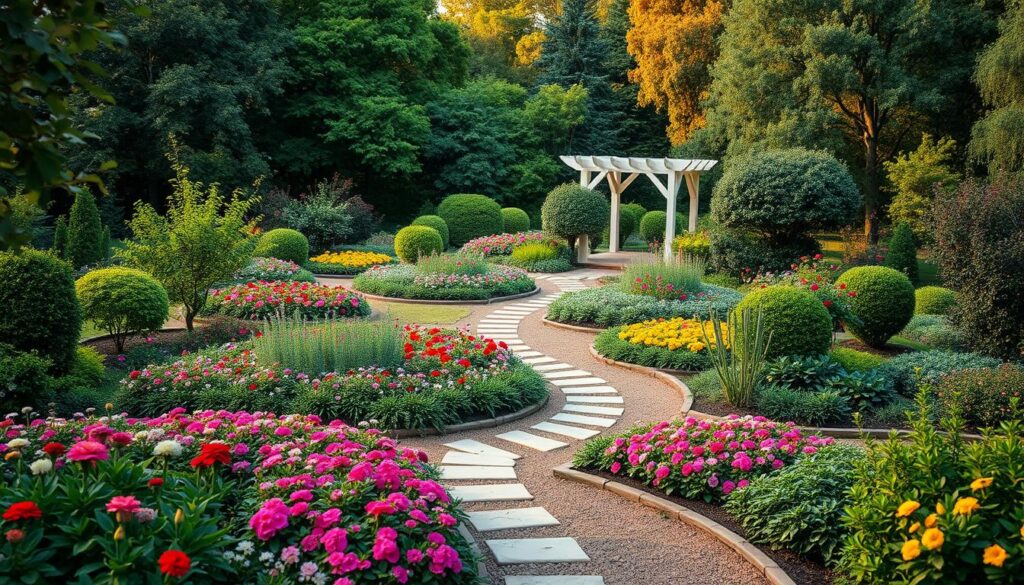
Key considerations like sunlight, climate, and maintenance level play a big role in success. For example, a sunny spot is perfect for vegetables, while shaded areas might suit ornamental plants. Understanding these factors helps you make informed choices.
Mixing ornamental and edible plants is a growing trend. It not only adds visual interest but also provides fresh produce. This approach maximizes your space and creates a balanced, productive environment.
Trending approaches like vertical gardening and pollinator support are gaining popularity. Vertical gardening is ideal for small spaces, while pollinator-friendly plants attract bees and butterflies, boosting biodiversity. These ideas combine practicality with environmental benefits.
1. Trellises: Vertical Gardening for Small Spaces
Vertical gardening with trellises opens up endless possibilities for small spaces. By growing upward, you can triple your growing area compared to traditional ground planting. This approach is perfect for urban settings or anyone looking to make the most of limited room.
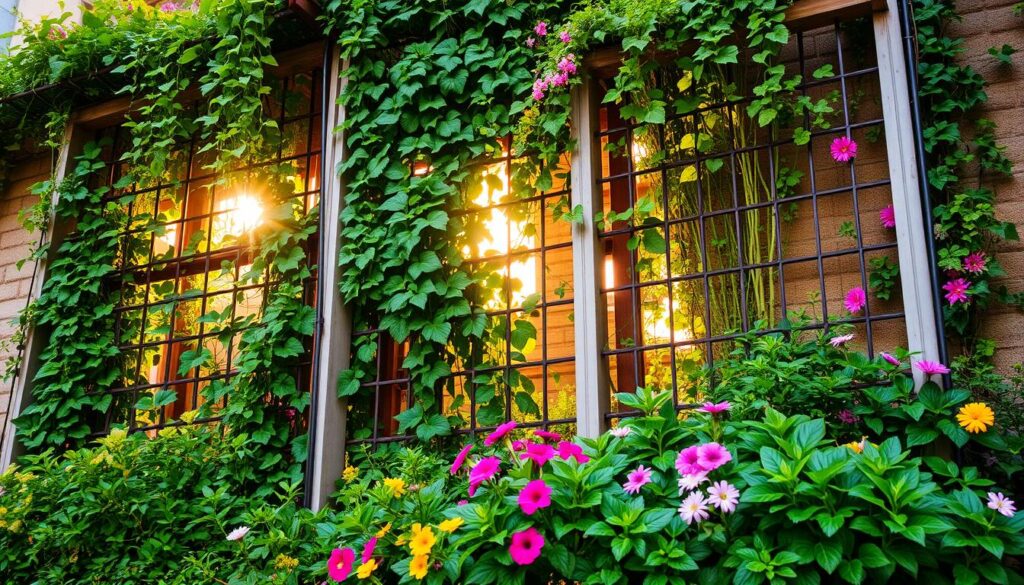
Why Trellises Are Essential
Trellises are a must-have for vining plants like tomatoes, cucumbers, and pole beans. They prevent overcrowding, improve air circulation, and reduce the risk of disease. Plus, they create stunning living walls that add beauty and structure to your outdoor area.
Best Plants for Trellises
Choose plants that naturally climb or vine for the best results. Tomatoes, cucumbers, and pole beans thrive on trellises. You can also grow flowering vines like morning glories for added visual appeal. Pair these with shade-tolerant greens like lettuce or spinach below for a productive and space-efficient setup.
Design Tips for Trellises
When designing with trellises, opt for durable materials like cedar or metal. These withstand weather and last for years. Consider using archways or T-shaped supports for a dynamic layout. For a polished look, explore Gardenary’s signature trellis systems, which combine functionality with elegance.
Companion planting is another smart strategy. Grow shade-loving plants beneath your trellises to maximize every inch of space. This not only boosts productivity but also creates a layered, lush environment.
2. Square-Foot Gardening: Maximize Your Space
Maximizing your growing area has never been easier with square-foot gardening. This method is perfect for small spaces, allowing you to grow a thriving vegetable garden in just a 4×4-foot bed. It’s a simple yet effective way to make the most of your available space.

What is Square-Foot Gardening?
Developed by Mel Bartholomew, square-foot gardening divides your growing area into one-foot squares. Each square is planted with a specific number of plants, depending on their size. This layout ensures efficient use of space and reduces wasted areas.
Benefits of Square-Foot Gardening
This method offers several advantages. First, it requires 80% less weeding than traditional row gardening. Second, succession planting allows for multiple harvests throughout the season. Finally, it’s ideal for beginners, as the grid system simplifies planning and maintenance.
How to Plan a Square-Foot Garden
Start by building a 4×4-foot raised bed. Fill it with a soil mix of 1/3 compost, 1/3 peat moss, and 1/3 vermiculite. This blend ensures proper drainage and nutrient availability. Next, create a grid to divide the bed into 16 one-foot squares.
Here’s a spacing chart for common vegetables:
| Vegetable | Plants per Square |
|---|---|
| Tomatoes | 1 |
| Carrots | 16 |
| Lettuce | 4 |
| Peppers | 1 |
Companion planting is another smart strategy. For example, pair tomatoes with basil to deter pests and enhance flavor. This approach not only maximizes productivity but also creates a balanced ecosystem in your beds.
Real gardeners have successfully used this method to grow abundant crops in small spaces. Whether you’re an urban dweller or just starting with gardening, square-foot gardening is a practical and rewarding choice.
3. Backyard Garden Layouts: Multi-Functional Spaces
Transforming your backyard into a multi-functional space can enhance both its beauty and practicality. Whether you’re creating a play area for kids, a relaxing retreat, or a productive growing zone, thoughtful planning ensures every inch of your yard works for you.

Designing for Family and Pets
When planning your space, consider the needs of your family and pets. Raised beds near play areas keep plants safe while providing easy access for little hands. Durable borders made of stone or pavers prevent trampling and add a polished look.
For pet owners, dog-friendly ground covers like clover are a great choice. They’re soft on paws and resilient to wear. Child-safe plants, such as sunflowers, add color and fun without posing risks.
Protecting Plants in Multi-Use Areas
In high-traffic zones, protective fencing is essential. Low barriers or decorative screens can shield delicate plants while maintaining the aesthetic. Storage solutions for toys and tools keep the area tidy and functional.
According to recent surveys, 63% of homeowners prefer combining edible and ornamental plants. This approach maximizes utility and visual appeal, creating a balanced environment.
Examples of Backyard Garden Layouts
Here are three real-world layouts that balance lawns, growing areas, and patios:
- Family-Friendly Layout: A central lawn surrounded by raised beds and a shaded patio.
- Pet-Friendly Design: Clover ground cover with a fenced vegetable patch and a dog run.
- Compact Urban Space: Vertical planters, a small patio, and integrated storage for tools.
Each layout demonstrates how to create a functional and inviting backyard that suits your lifestyle.
4. Raised Bed Gardens: Ideal for Challenging Soils
If your soil is clay-heavy or rocky, raised beds can be a game-changer. They allow you to create a controlled environment for your plants, bypassing poor ground conditions. With a height of 28 inches, these beds reduce bending by 70%, making them a back-friendly option for all gardeners.

Benefits of Raised Beds
Raised beds are perfect for areas with compacted or nutrient-poor soil. They provide better drainage, which is especially helpful in wet climates. The elevated design also keeps weeds at bay and makes it easier to manage pests. Plus, the soil warms up faster in spring, giving your plants a head start.
Materials for Building Raised Beds
When constructing raised beds, choose durable materials like rot-resistant cedar or composite. These options withstand weather and last for years. Cedar is a natural choice, while composite materials offer a low-maintenance alternative. Both ensure your beds remain sturdy and functional.
Layout Ideas for Raised Bed Gardens
Consider U-shaped layouts for easy access from all sides. This design is particularly useful for wheelchair-accessible setups. For wet climates, add gravel or perforated pipes beneath the beds to improve drainage. You can also mix and match sizes to create a visually appealing arrangement.
Here’s a quick comparison of DIY vs pre-fab kits:
- DIY: Cost-effective and customizable, but requires more time and effort.
- Pre-fab Kits: Convenient and easy to assemble, though slightly more expensive.
To keep your raised beds productive, follow a soil amendment schedule. Add compost or organic matter annually to maintain nutrient levels. This ensures your plants thrive season after season.
5. Kitchen Gardens: Fresh Herbs and Vegetables at Your Doorstep
Bringing fresh flavors to your doorstep has never been easier with a kitchen garden. This compact and functional setup allows you to grow herbs and vegetables just steps away from your kitchen. Whether you’re a seasoned cook or a beginner, having fresh ingredients on hand can elevate your meals.
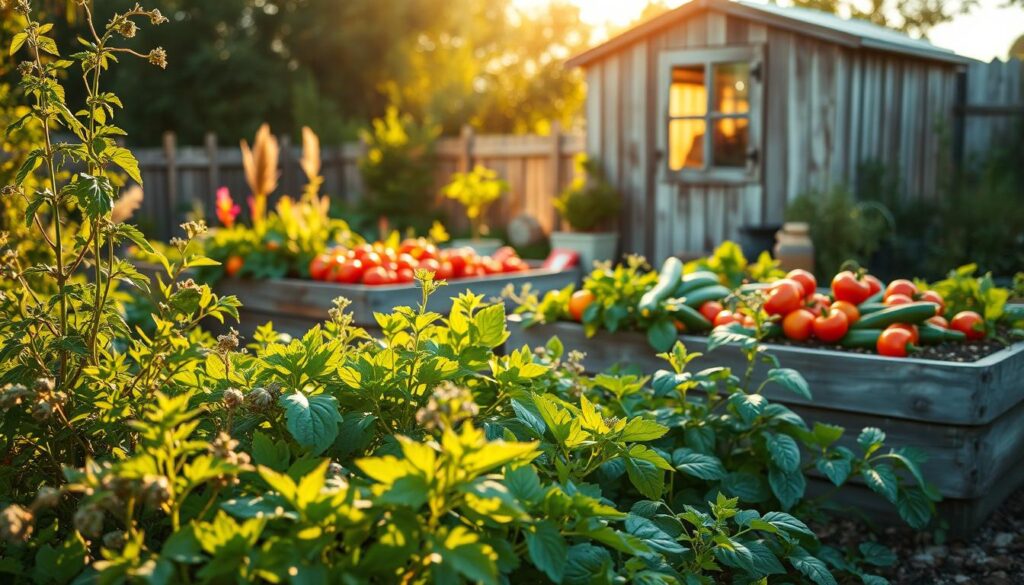
What is a Kitchen Garden?
A kitchen garden is a small, dedicated area for growing edible plants. It’s designed for convenience, placing fresh produce within easy reach. Unlike larger setups, it focuses on high-yield, quick-growing varieties that suit everyday cooking needs.
Plants to Include in a Kitchen Garden
When planning your kitchen garden, choose plants that thrive in small spaces and offer frequent harvests. Basil, arugula, and cherry tomatoes are excellent choices. Incorporating edible flowers like nasturtiums adds color and flavor to your dishes.
Here’s a list of quick-growing varieties:
- Basil: Ready in 4-6 weeks.
- Arugula: Harvest in 3-4 weeks.
- Cherry Tomatoes: Produce fruit in 60-70 days.
Designing a Functional Kitchen Garden
Creating a functional kitchen garden requires thoughtful planning. Start by selecting a sunny spot close to your kitchen. Ensure path widths are at least 18 inches for easy access and harvesting.
Incorporate decorative elements like obelisks or trellises to add vertical interest. Pollinator attractors, such as lavender or marigolds, can boost yields by encouraging beneficial insects.
Here’s a comparison of six popular layouts:
| Layout | Features |
|---|---|
| Rectangular | Simple and space-efficient. |
| U-Shaped | Easy access from all sides. |
| Circular | Visually appealing and compact. |
| Vertical | Maximizes small spaces. |
| Raised Bed | Ideal for poor soil conditions. |
| Container | Portable and versatile. |
With these tips, you can create a kitchen garden that’s both practical and beautiful, ensuring fresh ingredients are always within reach.
6. Homestead Gardens: Self-Sufficiency and Market Gardens
Achieving self-sufficiency through a homestead garden is both rewarding and practical. These setups are ideal for properties ranging from 1/4 to 5 acres, offering a blend of food production and sustainability. Whether you’re growing for your family or selling at local markets, homestead gardens provide a path to independence.
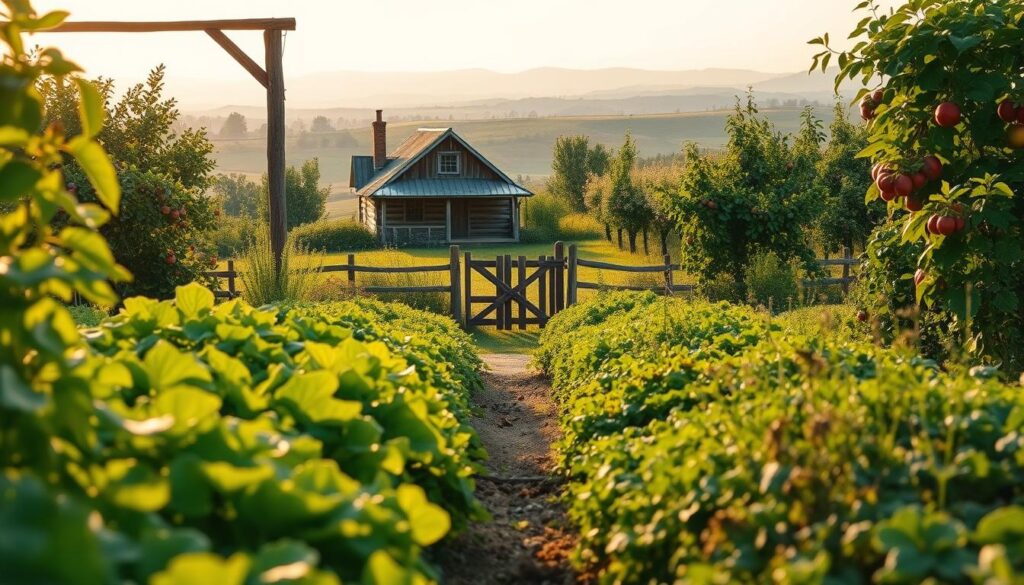
What is a Homestead Garden?
A homestead garden is a multi-functional space designed for food production and sustainability. It often includes a vegetable garden, fruit trees, and sometimes livestock. The goal is to create a self-sustaining system that meets your household’s needs while reducing reliance on external resources.
Planning a Homestead Garden
Effective planning is key to a successful homestead garden. Start by assessing your space and sunlight availability. Crop rotation is essential to maintain healthy soil and prevent pest buildup. For example, rotate legumes with leafy greens to replenish nitrogen levels.
Rainwater collection systems can enhance sustainability. Install barrels or tanks to capture runoff, reducing your reliance on municipal water. This is especially useful in areas with seasonal rainfall.
Integrating Livestock and Bees
Adding livestock like chickens or goats can boost productivity. Chicken tractors, for instance, fertilize the soil while controlling pests. Goats are excellent for clearing brush, but sturdy fencing is necessary to protect your vegetable garden.
Bees are another valuable addition. They pollinate crops and produce honey. Place hives near flowering plants for optimal results. Ensure they’re positioned away from high-traffic areas to avoid disturbances.
High-value crops like microgreens and heirloom varieties can maximize your market garden’s profitability. These crops often yield $2-5 per square foot, making them a smart choice for small-scale growers.
“A well-planned homestead garden can provide fresh food, reduce expenses, and support a sustainable lifestyle.”
With thoughtful planning and the right tools, your homestead garden can become a thriving, self-sufficient ecosystem.
7. Small Space Gardens: Making the Most of Limited Areas
Small spaces can still yield big results with the right approach. Whether you’re working with a balcony, patio, or even a fire escape, creative solutions can turn any small space into a productive and beautiful area. With 65% of urban growers using vertical systems, it’s clear that innovation is key to maximizing limited room.
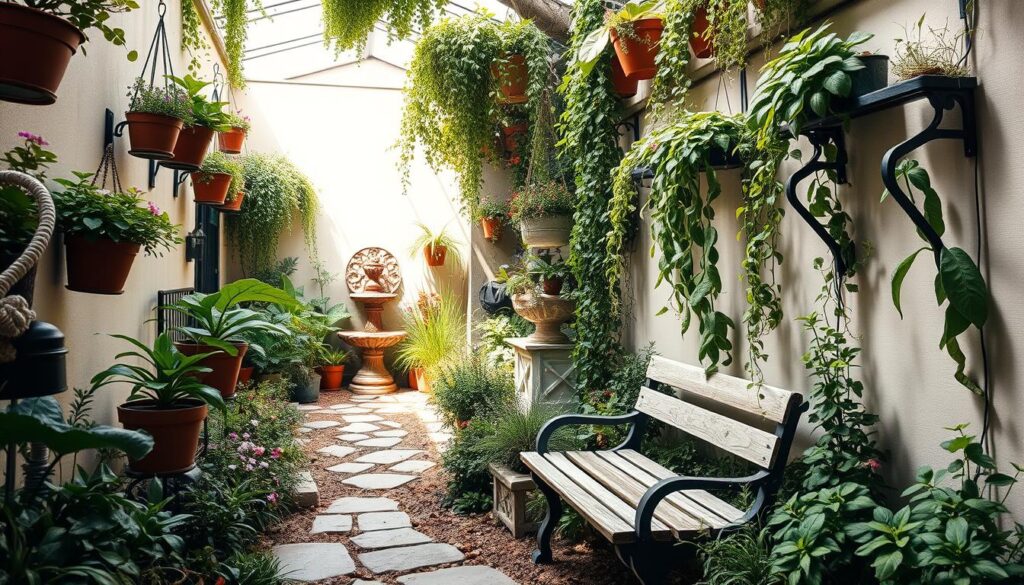
Prioritizing Crops for Small Gardens
When space is limited, choosing the right crops is essential. Focus on high-yield, compact varieties like Patio Princess tomatoes or dwarf beans. These plants take up less room while providing abundant harvests. Intercropping, such as pairing lettuce with radishes, is another smart way to double your output in the same area.
Creative Planting Techniques
Vertical gardening is a game-changer for small spaces. Use balcony rail planters or hanging gutter systems to grow upward. Stacked planters create microclimates, allowing you to grow multiple crops in a compact setup. Dwarf varieties, which increase yields by 40%, are perfect for these creative arrangements.
Examples of Small Space Gardens
Here are three practical setups for limited areas:
- Balcony Rail Planters: Perfect for herbs and leafy greens, these keep plants off the ground and within easy reach.
- Fire Escape Gardens: Ensure safety by using lightweight containers and securing them properly.
- Hanging Gutter Gardens: Ideal for strawberries or trailing flowers, these add vertical interest and functionality.
For those with minimal room, compact varieties like Patio Princess tomatoes or Baby Leaf lettuce are excellent choices. These plants thrive in containers and require little maintenance.
| Plant | Space Requirement |
|---|---|
| Patio Princess Tomatoes | 1 square foot |
| Dwarf Beans | 6 inches apart |
| Baby Leaf Lettuce | 4 inches apart |
With these tips, even the tiniest areas can become thriving green zones. Whether you’re an urban dweller or just starting, these strategies ensure your small space works for you.
8. Drought-Resistant Gardens: Thriving in Dry Climates
In dry climates, creating a thriving outdoor space requires smart water management. By using efficient techniques and choosing the right plants, you can transform arid areas into lush, sustainable zones. These setups not only conserve resources but also add beauty to your surroundings.

Water-Efficient Gardening Techniques
Drip irrigation is a game-changer for dry climates, reducing water usage by 50%. This system delivers moisture directly to the roots, minimizing waste. Adding mulch can lower evaporation by 70%, keeping the soil moist for longer periods.
Rainwater harvesting is another effective strategy. Install barrels or tanks to collect runoff, ensuring a steady supply during dry spells. These methods not only save water but also reduce your reliance on municipal sources.
Best Plants for Dry Gardens
Native plants are ideal for drought-resistant setups, requiring 75% less water than non-native species. Succulents like Agave and Sedum are excellent choices due to their low maintenance and ability to store moisture.
Here’s a list of top picks for dry climates:
- Agave: Thrives in full sun and requires minimal care.
- Sedum: Perfect for rock gardens and containers.
- Lavender: Adds fragrance and attracts pollinators.
Designing a Drought-Resistant Garden
Xeriscaping is a popular approach, using gravel, rocks, and drought-tolerant plants to create a visually appealing layout. Swales, shallow ditches, can redirect rainwater to nourish your garden naturally.
For a polished look, consider gravel designs with pathways and decorative elements. These not only enhance aesthetics but also reduce water runoff. Pair these with native plants for a low-maintenance, eco-friendly setup.
“A well-planned drought-resistant garden can thrive with minimal resources, offering beauty and sustainability.”
By implementing these techniques, you can create a vibrant outdoor space that thrives even in the driest conditions. Explore more tips at NewGen Living for inspiration and guidance.
9. Flower Gardens: Beauty and Pollinator Support
Flowers bring life and color to any outdoor space, creating a vibrant and inviting atmosphere. Whether you’re looking to enhance your landscape or support local wildlife, a flower-filled area offers endless possibilities. From attracting pollinators to providing fresh blooms for your home, these setups are both practical and beautiful.
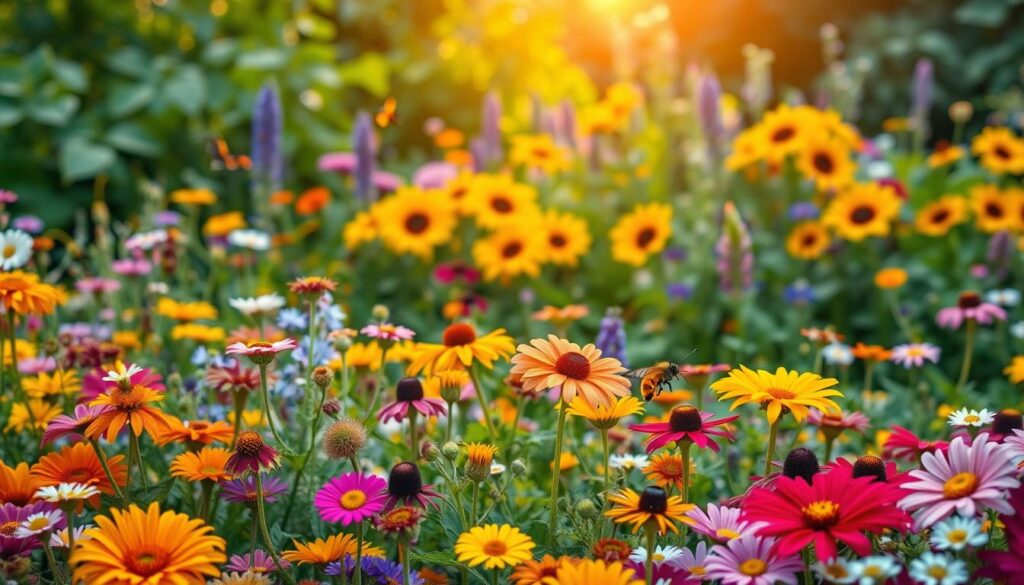
Benefits of Flower Gardens
Flower gardens are more than just visually appealing. Native flowers support four times more pollinators than non-native species, making them essential for local ecosystems. Succession blooming ensures your space remains colorful throughout the seasons, while cutting gardens can yield up to 50 stems per week for fresh arrangements.
Choosing the Right Flowers
Selecting the right blooms is key to a thriving flower garden. Deer-resistant varieties like Lavender and Echinacea are excellent choices for areas with wildlife. Fragrant plants such as Stock and Nicotiana add a sensory element, while butterfly puddling stations attract and support pollinators.
Designing a Flower Garden
When designing your flower garden, consider color themes and plant heights for a cohesive look. Here’s a 3-season bloom chart to help you plan:
| Season | Flowers |
|---|---|
| Spring | Tulips, Daffodils, Pansies |
| Summer | Sunflowers, Zinnias, Lavender |
| Fall | Chrysanthemums, Asters, Sedum |
By incorporating these tips, you can create a flower garden that’s both stunning and beneficial to the environment. Whether you’re a seasoned gardener or just starting, these ideas will help you bring your vision to life.
10. Companion Planting Gardens: Natural Pest Control
Companion planting is a natural way to boost your garden’s health and productivity. By pairing specific plants together, you can deter pests, improve soil quality, and enhance flavors. This method has been used for centuries and remains a favorite among modern gardeners.
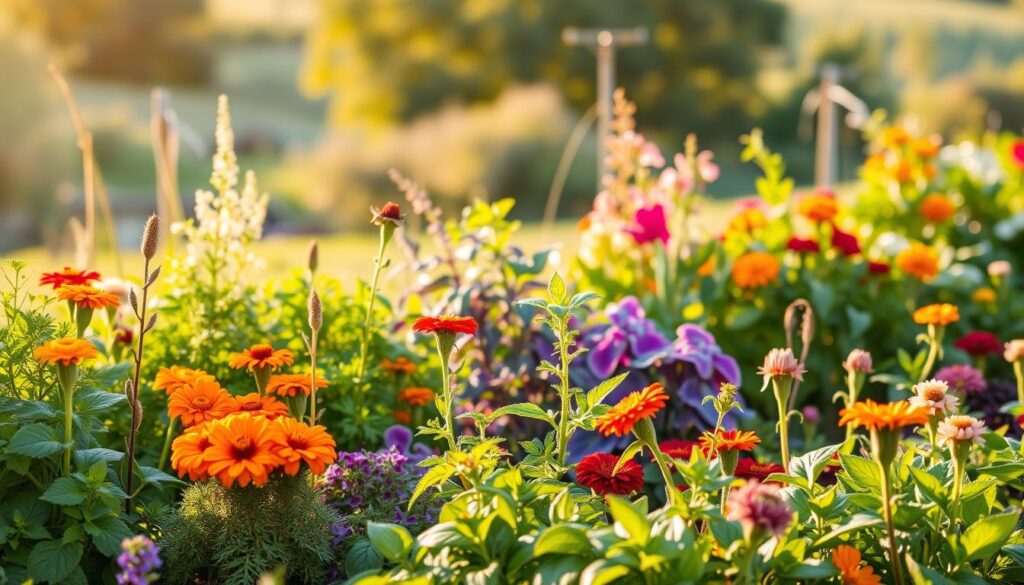
What is Companion Planting?
Companion planting involves growing certain plants near each other to benefit one or both. For example, marigolds reduce nematodes by 90%, making them a great partner for tomatoes. Basil not only improves tomato flavor but also repels harmful insects. This technique creates a balanced ecosystem in your garden.
Best Companion Plants
Choosing the right pairings is key to success. Here are some proven combinations:
- Tomatoes and Basil: Basil enhances flavor and deters pests.
- Corn, Beans, and Squash: Known as the Three Sisters, this trio increases yields and supports each other’s growth.
- Carrots and Onions: Onions repel carrot flies, while carrots loosen the soil for onions.
Aromatic herbs like rosemary and thyme also act as natural barriers against pests.
Designing a Companion Planting Garden
When planning your layout, consider trap cropping strategies. For instance, plant nasturtiums to attract aphids away from your vegetables. Incorporate beneficial insect hotels to attract pollinators and predators like ladybugs.
Guild planting patterns, such as grouping fruit trees with nitrogen-fixing plants, can also enhance productivity. Here’s a simple layout example:
| Plant | Companion | Benefit |
|---|---|---|
| Tomatoes | Marigolds | Reduces nematodes |
| Beans | Corn | Provides natural trellis |
| Cucumbers | Radishes | Deters cucumber beetles |
With thoughtful planning, companion planting can transform your garden into a thriving, pest-resistant ecosystem.
11. Partial-Shade Gardens: Growing in Low Light
Not all outdoor spaces are blessed with full sunlight, but that doesn’t mean they can’t thrive. Partial-shade areas, receiving 4-6 hours of sunlight daily, are perfect for growing a variety of plants. With the right strategies, you can turn these spots into lush, productive zones.
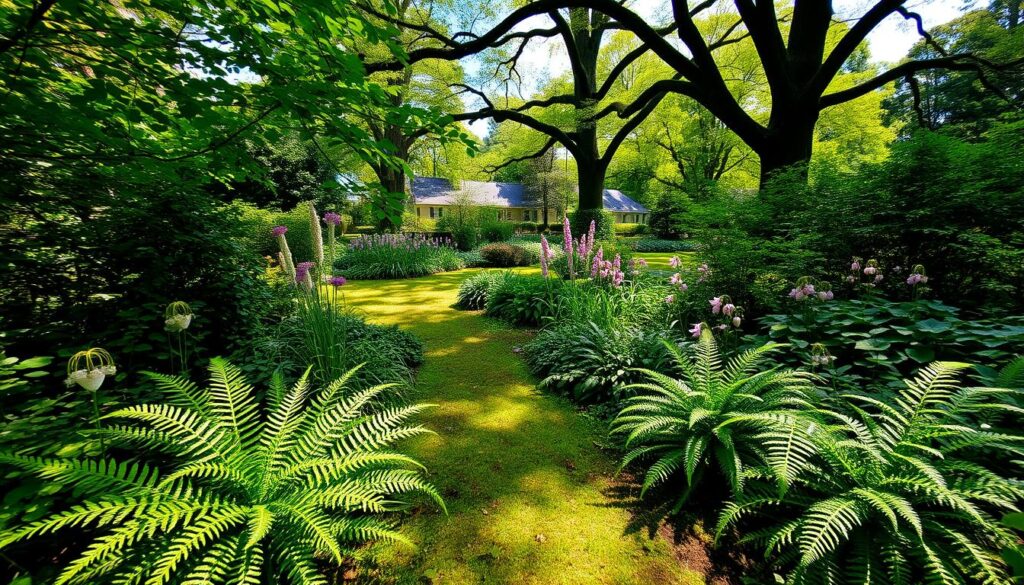
Shade-Tolerant Vegetables
Leafy greens like kale and spinach are ideal for low-light conditions, requiring only 4 hours of sun. Other shade-tolerant options include lettuce, arugula, and Swiss chard. These plants thrive in cooler, less intense light, making them perfect for shaded areas.
For root vegetables, consider radishes and beets. They grow well in partial shade and can be paired with reflective mulch to maximize available light. This technique increases light exposure by up to 20%, helping your garden flourish.
Design Tips for Partial-Shade Gardens
Use white surfaces or reflective materials to bounce light onto your plants. Shade cloth can create dappled light, mimicking natural forest conditions. This setup is especially useful for woodland-inspired designs.
Containers are a great solution for areas with root competition. They allow you to control soil quality and drainage, ensuring your plants get the nutrients they need. Pair these with edible mushroom logs for a unique, multi-layered approach.
Examples of Partial-Shade Gardens
- Woodland Garden: Incorporate ferns, hostas, and shade-loving flowers for a natural look.
- Container Garden: Use pots for herbs and leafy greens, perfect for small spaces.
- Edible Shade Garden: Combine vegetables like kale and spinach with edible flowers for a functional and beautiful setup.
“Partial shade doesn’t limit your options—it opens up new possibilities for creativity and productivity.”
With these tips, you can transform low-light areas into thriving, productive zones. Whether you’re working with a shaded backyard or a small balcony, partial-shade gardening offers endless opportunities.
12. Meadow Gardens: Natural Beauty and Wildlife Support
Meadow gardens offer a blend of natural beauty and ecological benefits, making them a sustainable choice for any landscape. These setups not only enhance visual appeal but also support local wildlife, creating a thriving ecosystem in your outdoor space.
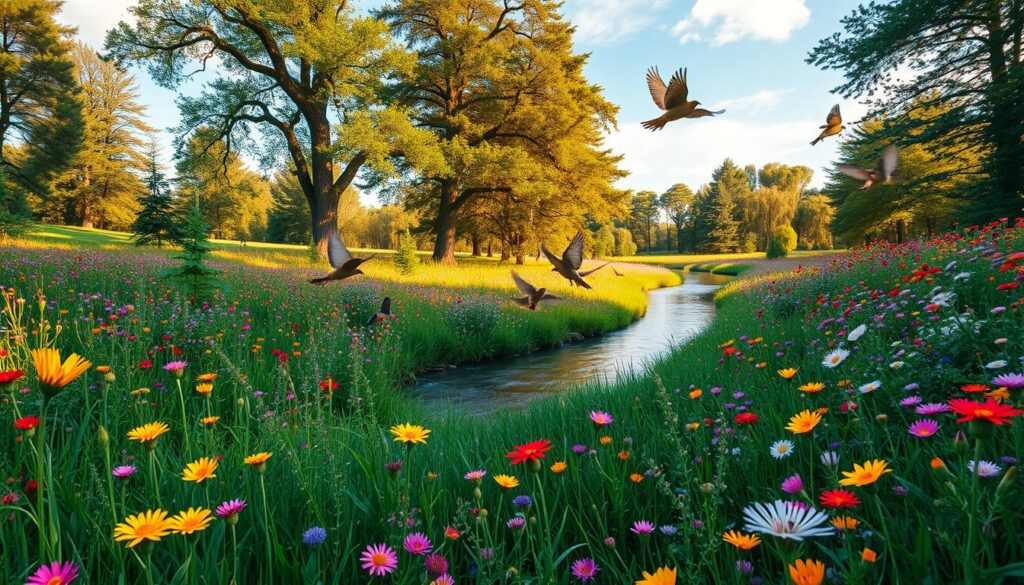
Benefits of Meadow Gardens
Meadow gardens support 10 times more pollinators than traditional lawns, making them essential for biodiversity. They require 90% less maintenance than turf, saving time and resources. Native grasses in these setups also prevent soil erosion, ensuring long-term stability.
Choosing the Right Plants
Selecting the right plants is crucial for a successful meadow garden. Controlled wildflower mixes add vibrant colors and attract pollinators. Drought-tolerant perennials like Black-Eyed Susans and Coneflowers thrive in these conditions, requiring minimal care.
Designing a Meadow Garden
Incorporate mowing pathways to create a structured yet natural look. High Line-inspired designs blend urban aesthetics with ecological benefits. Adding bird habitat features, such as nesting boxes, enhances wildlife support and adds charm to your landscape.
Here’s a quick guide to meadow garden essentials:
- Wildflowers: Choose native varieties for pollinator support.
- Grasses: Use native species to prevent erosion.
- Pathways: Mow trails for easy access and visual appeal.
- Bird Features: Add nesting boxes or birdbaths.
“A meadow garden combines natural beauty with ecological benefits, creating a sustainable and vibrant outdoor space.”
With thoughtful planning, meadow gardens can transform your landscape into a haven for both people and wildlife. Whether you’re an experienced gardener or just starting, these tips will help you create a thriving, low-maintenance oasis.
13. Sensory Gardens: Engaging All Five Senses
Engaging all five senses in your outdoor space can create a truly immersive experience. Sensory gardens are designed to stimulate sight, smell, touch, taste, and hearing, making them a perfect retreat for relaxation and exploration. These setups are ideal for anyone looking to connect deeply with nature.
What is a Sensory Garden?
A sensory garden is a thoughtfully curated space that appeals to all five senses. It combines plants, textures, scents, and sounds to create a multi-dimensional experience. Whether you’re looking to unwind or engage with nature, these gardens offer something for everyone.
Plants for Sensory Gardens
Choosing the right plants is key to a successful sensory garden. Lamb’s Ear provides soft, velvety leaves for tactile interest, while night-blooming flowers like Moonflower add a captivating scent. Chocolate cosmos not only smell delightful but also add visual beauty with their deep, rich colors.
Edible flowers like nasturtiums and pansies can be included for tasting stations. These herbs and blooms add both flavor and color, making your garden a feast for the senses.
Designing a Sensory Garden
When designing a sensory garden, consider incorporating textured paths made of pebbles or bark. These add a tactile element and make the space more accessible. Wind chimes or water features introduce soothing sounds, enhancing the auditory experience.
Here’s a simple layout to inspire your design:
| Element | Purpose |
|---|---|
| Lamb’s Ear | Tactile interest |
| Moonflower | Nighttime scent |
| Chocolate Cosmos | Visual and olfactory appeal |
| Water Feature | Auditory stimulation |
ADA-compliant designs ensure everyone can enjoy the space. Raised beds and wide pathways make it easy for wheelchair users to navigate and interact with the garden.
“A sensory garden is more than just a space—it’s an experience that connects you with nature on every level.”
With thoughtful planning, your sensory garden can become a sanctuary that delights all five senses. Whether you’re designing for relaxation or exploration, these tips will help you create a space that’s both functional and enchanting.
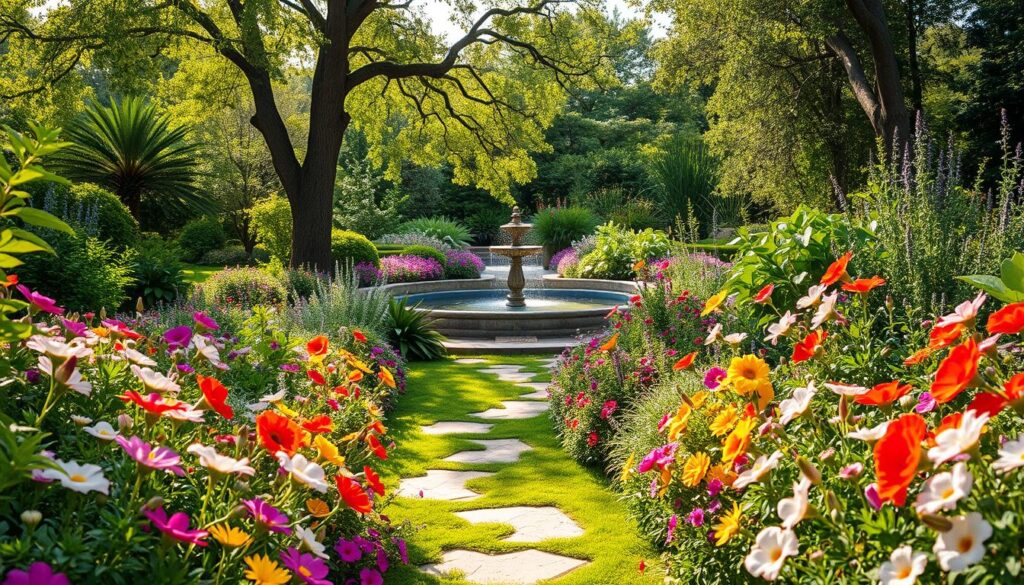
14. Formal Gardens: Elegance and Structure
Formal gardens bring timeless elegance and structure to any outdoor space. Known for their precise layouts and symmetrical patterns, these gardens create a sense of order and sophistication. Whether inspired by classic European estates or modern interpretations, formal gardens are a perfect blend of beauty and meticulous planning.
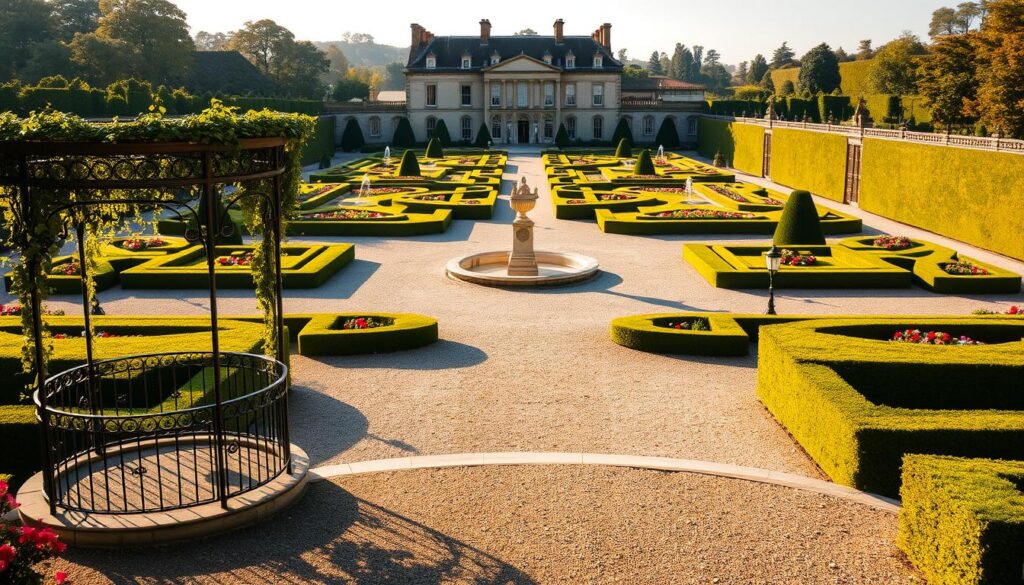
Elements of Formal Gardens
Geometric patterns are a hallmark of formal gardens, increasing the perceived space and adding visual interest. Boxwood parterres, which can last over 50 years, are often used to create intricate designs. Symmetry plays a key role, offering a balanced and harmonious look that appeals to the eye.
Evergreen plants like boxwood and yew provide year-round structure, ensuring the landscape remains vibrant in every season. Focal points such as statues, fountains, or topiaries add a touch of grandeur, drawing attention and enhancing the overall design.
Designing a Formal Garden
When planning a formal garden, start with a clear layout. Versailles-inspired designs are a popular choice, featuring grand allées lined with trees and geometric flower beds. Knot gardens, with their interwoven patterns, are another timeless option.
Here are some tips to get started:
- Choose evergreen plants for year-round structure and low maintenance.
- Incorporate focal points like fountains or statues to create visual interest.
- Use symmetry to achieve a balanced and harmonious look.
Examples of Formal Gardens
Versailles-inspired layouts are a classic example, showcasing grand allées and intricate parterres. For a more compact space, consider a knot garden with interwoven patterns of herbs or flowers. These designs not only enhance the beauty of your outdoor area but also reflect a timeless style.
Here’s a quick guide to popular formal garden elements:
| Element | Purpose |
|---|---|
| Boxwood Parterres | Create intricate designs and lasting structure. |
| Allée Trees | Line pathways for a grand, symmetrical look. |
| Focal Points | Add grandeur and draw attention. |
“A formal garden is more than just a space—it’s a statement of elegance and precision.”
With thoughtful planning, formal gardens can transform your outdoor area into a sophisticated retreat. Whether you’re inspired by classic designs or modern interpretations, these ideas will help you create a space that’s both beautiful and functional.
15. Cottage Gardens: Charm and Color
Cottage gardens evoke a sense of nostalgia and charm, blending vibrant colors and natural beauty. These spaces are known for their relaxed, informal style, often featuring a mix of flowers, herbs, and climbers. With their whimsical appeal, they bring a touch of countryside elegance to any outdoor area.
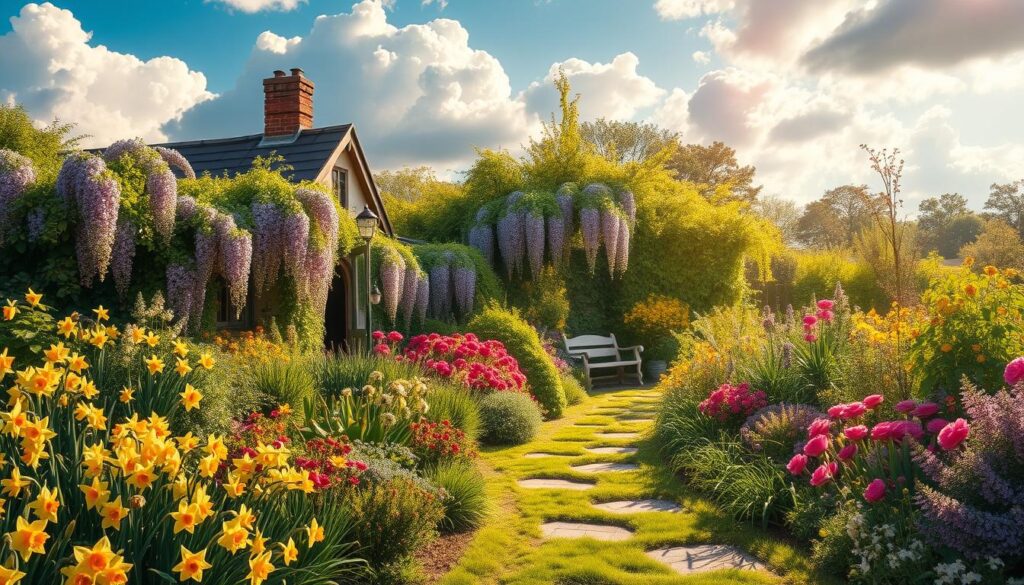
What is a Cottage Garden?
A cottage garden is a traditional garden style that originated in England. It’s characterized by its dense planting, combining ornamental and edible plants. The design often includes pathways, picket fences, and vintage elements, creating a cozy and inviting atmosphere.
Self-seeding plants like poppies and foxgloves are commonly used, reducing maintenance costs while adding a natural, unstructured look. This approach allows the garden to evolve over time, reflecting the beauty of imperfection.
Plants for Cottage Gardens
Choosing the right plants is essential for achieving the cottage garden look. Rambling roses, such as ‘New Dawn’ or ‘Eden,’ soften structures and add romantic charm. Other popular choices include:
- Lavender: Adds fragrance and attracts pollinators.
- Delphiniums: Provide height and vibrant color.
- Hollyhocks: Perfect for adding vertical interest.
Repeating seven key plants throughout the space creates cohesion and ties the design together. Climbers like clematis and honeysuckle can be trained to grow over arches or fences, enhancing the garden’s layered look.
Designing a Cottage Garden
When planning your cottage garden, consider these strategies to maximize its charm:
- Picket Fences: White picket fences add a classic touch and define the space.
- Color Palettes: Use soft pastels or bold hues to create a harmonious look.
- Pathway Edging: Use bricks or stones to outline pathways for a polished finish.
- Vintage Displays: Incorporate antique tools or weathered benches for character.
Pathways can be lined with low-growing plants like thyme or chamomile, adding texture and fragrance. For a cohesive style, mix perennials and annuals to ensure year-round interest.
“A cottage garden is a celebration of nature’s beauty, blending structure with spontaneity to create a timeless retreat.”
With thoughtful planning, your cottage garden can become a vibrant and enchanting space. Whether you’re a seasoned gardener or just starting, these tips will help you bring your vision to life.
Conclusion: Transform Your Garden with These Design Plans
Transforming your outdoor area into a personalized retreat is simpler than you might imagine. With thoughtful planning, you can create a space that’s both functional and beautiful, tailored to your lifestyle and needs.
Start small by focusing on one or two elements, like adding a few plants or creating a cozy seating area. This approach makes the process manageable and rewarding. For more guidance, explore downloadable resources to help you map out your vision.
Joining local groups can also provide inspiration and support. Sharing ideas with others can spark creativity and help you learn new techniques. Stay tuned for upcoming seasonal guides to keep your garden thriving year-round.

